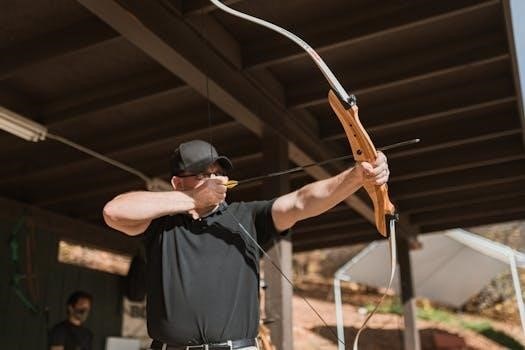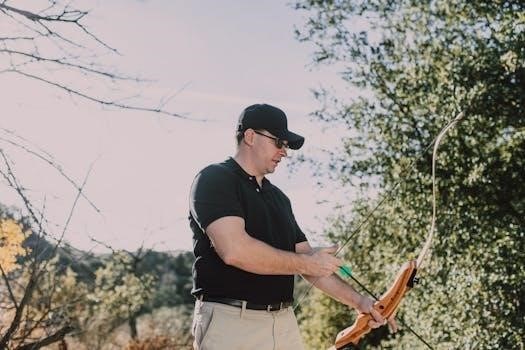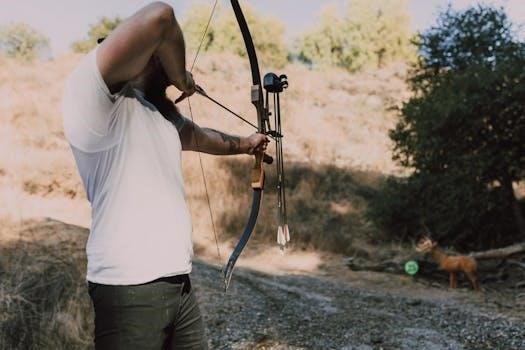Semi-Guided Elk Hunts⁚ An Overview
Semi-guided elk hunts offer a unique blend of independence and support․ These hunts provide access to prime hunting locations, often on private land leases, with experienced guides offering assistance in finding elk․ Participants are responsible for field dressing their harvested animals․
What is a Semi-Guided Elk Hunt?
A semi-guided elk hunt bridges the gap between fully guided and unguided experiences, offering a balance of support and independence․ Typically, it includes lodging, meals, and some level of assistance from experienced outfitters or guides․ Unlike a fully guided hunt where the guide is with you every step of the way, in a semi-guided hunt, the guide may provide initial direction, advice on hunting strategies, and placement in areas with a high probability of finding elk․ However, hunters are generally responsible for the actual hunting process, including field dressing and preparing the animal for transport, with the outfitter providing logistical support․
Cost Considerations for Semi-Guided Elk Hunts
The cost of semi-guided elk hunts varies widely, influenced by factors like location, duration, included services, and the quality of the hunting area․ These hunts generally cost less than fully guided options․
Typical Price Ranges for Semi-Guided Hunts
Semi-guided elk hunts exhibit a considerable price range, typically spanning from $2,500 to $7,500 or more, varying greatly by location and outfitter․ Drop camp hunts, a basic form of semi-guided, may start at the lower end, around $2,500 to $3,000 per hunter, while hunts on private land with lodging and some meals can fall in the $4,500 to $5,500 range․ Premium semi-guided hunts with additional services or access to prime areas may reach prices of $7,500 or higher․ It’s crucial to research and compare offerings carefully․
Factors Affecting the Cost of Semi-Guided Elk Hunts
Several factors influence the cost of semi-guided elk hunts․ The location, particularly whether it’s on private land or public land, plays a significant role, with private land leases generally being more expensive․ The duration of the hunt, the quality of lodging, meals, and the level of guidance provided also impact the overall price․ The type of hunt (rifle, archery, or muzzleloader) and the potential for trophy-sized elk can further affect costs․ Additionally, hunts with a higher probability of harvesting an elk may be priced higher, and some outfitters also offer premium packages at increased rates․

What’s Included in a Semi-Guided Elk Hunt Package?
Semi-guided elk hunt packages typically include lodging, meals, and basic guidance․ Some packages may also include transportation to and from the hunting areas, enhancing the overall experience․
Common Inclusions⁚ Lodging, Meals, and Basic Guidance
Most semi-guided elk hunts offer comfortable lodging, which can range from cabins to lodges, ensuring a restful stay․ Meals are generally provided, often including breakfast and dinner, designed to fuel hunters for long days․ Basic guidance involves assistance with navigating the hunting area and understanding elk behavior, but hunters are expected to actively participate in the hunt․ This level of support aims to balance independence with the necessary help for a successful experience․ Some packages may offer additional amenities, but these core components are standard for most semi-guided elk hunts․

The Role of Guides in Semi-Guided Hunts
In semi-guided elk hunts, guides offer crucial support by identifying high-probability elk areas․ They assist with hunting strategies, but the hunter is ultimately responsible for the hunt itself․
Assistance with Location and Hunting Strategies
Guides in semi-guided elk hunts play a key role in maximizing hunters’ chances of success․ They leverage their knowledge of the hunting area, often private land leases, to position hunters in locations with high elk activity․ This assistance includes providing insights into elk behavior, movement patterns, and preferred habitats․ Guides may also offer advice on effective hunting techniques, such as calling strategies or optimal times for ambushing elk․ However, the actual hunting is performed by the hunter, promoting an experience that blends guidance with independence and skill development․

Land Access and Hunting Areas
Semi-guided elk hunts often take place on private land leases, offering hunters exclusive access to prime elk habitat․ These areas may include diverse terrains like river bottoms, pines, and oak brush․
Private Land Leases vs․ Public Land
Semi-guided elk hunts frequently utilize private land leases, which offer a distinct advantage over public land․ Private land often boasts less hunting pressure and better-managed game populations, increasing the odds of a successful hunt․ These leases can provide access to specific terrains like alfalfa fields, river bottoms, pines, and oak brush, attracting elk․ Public land, while accessible, can be more crowded and may require more scouting effort․ Private land leases typically come with the benefit of guidance from experienced outfitters familiar with the area’s elk patterns, further enhancing the hunting experience․
Physical Requirements and Preparation
Semi-guided elk hunts often require a good level of physical fitness, especially if riding horses․ Hunters should be prepared for extended days in the field and be able to handle riding for long periods of time․
Fitness for Riding and Extended Hunting Days
Participating in a semi-guided elk hunt often demands a significant level of physical stamina․ Many hunts involve extensive horseback riding, sometimes for eight hours or more on both pack-in and pack-out days․ Hunters should be prepared for long days spent actively moving through rugged terrain․ This level of activity requires a good baseline of fitness, including cardiovascular endurance and leg strength․ It is essential that hunters assess their physical capabilities realistically before booking such a hunt, ensuring they can comfortably handle the rigors of riding and walking, to fully enjoy the experience without undue strain or injury․

Tipping Etiquette for Guides
Tipping guides is customary in semi-guided elk hunts․ A gratuity of 15-20% of the total hunt cost is standard․ It is recommended to use cash or a separate check for tips․
Standard Gratuity Practices and Amounts
When participating in a semi-guided elk hunt, it is customary to tip your guides and other staff for their services․ The standard gratuity amount typically falls between 15% to 20% of the total hunt cost․ This is a common practice in the hunting industry․ It is generally preferred to provide tips in cash or via a separate check․ This ensures that the guides and other staff receive their tips directly․ Remember that this is a way to show your appreciation for their hard work and dedication in making your hunting experience a success․ Consider tipping individually or as a group․
Booking and Deposit Information
Booking a semi-guided elk hunt typically requires a deposit, often around $1000 for individual hunters․ Deposits are usually non-refundable within three months of the hunt date․ Check specific outfitter’s policies․
Deposit Requirements and Refund Policies
Securing your spot on a semi-guided elk hunt generally involves a deposit, often around $1000 for individuals, while group hunts may require larger deposits, sometimes $3000․ These deposits are crucial for reserving your hunt dates and ensuring the outfitter’s commitment․ However, it’s essential to understand that these deposits are typically non-refundable if you cancel within three months of your scheduled hunt․ Always confirm the specific refund terms with your chosen outfitter before booking, as policies can vary․ Be sure to review the payment schedule and the method for payments carefully․
